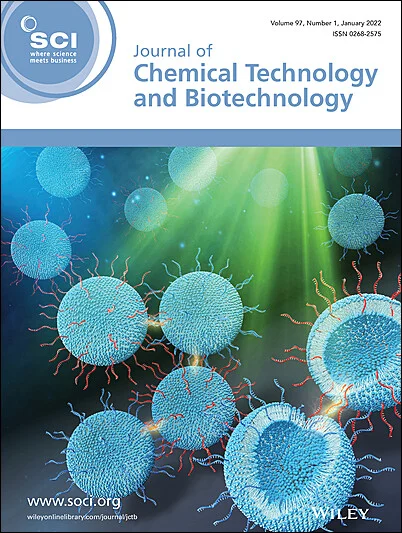Imran Ali, Gunel Imanova, Teymur Agayev, Anar Aliyev, Abdulaziz Bentalib, Tonni Agustiono Kurniawan, Xavier Yangkou Mbianda
求助PDF
{"title":"纳米beo光催化剂在γ射线裂解中水分解的可持续制氢研究","authors":"Imran Ali, Gunel Imanova, Teymur Agayev, Anar Aliyev, Abdulaziz Bentalib, Tonni Agustiono Kurniawan, Xavier Yangkou Mbianda","doi":"10.1002/jctb.7876","DOIUrl":null,"url":null,"abstract":"<div>\n \n \n <section>\n \n <h3> Background</h3>\n \n <p>There is a great demand for green hydrogen energy due to climate issues and economic pressures globally. Therefore, hydrogen production was achieved by water splitting using a nano-BeO photocatalyst.</p>\n </section>\n \n <section>\n \n <h3> Results</h3>\n \n <p>The hydrogen produced using BeO + H<sub>2</sub>O<sub>ads</sub> and nano-BeO + H<sub>2</sub>O<sub>liq</sub> systems was 9.0 × 10<sup>16</sup> (at 7 h) and 32.8 × 10<sup>16</sup> (at 5 h) molecules g<sup>−1</sup> at 300 K. The hydrogen production was optimized by raising the temperature in the BeO + H<sub>2</sub>O<sub>ads</sub> system and the maximum hydrogen obtained was 7.0 × 10<sup>17</sup> and 8.5 × 10<sup>17</sup> molecules g<sup>−1</sup> in thermal and radiation–thermal processes at 673 K for 5 h. The ranges of the values of <i>W</i><sub>Т</sub>(Н<sub>2</sub>), <i>W</i><sub>R</sub>(Н<sub>2</sub>) and <i>W</i><sub>RT</sub>(Н<sub>2</sub>) at 373, 473, 573 and 673 K were 2.34 × 10<sup>13</sup> to 37.9 × 10<sup>13</sup>, 8.8 × 10<sup>13</sup> to 51.6 × 10<sup>13</sup> and 9.22 × 10<sup>13</sup> to 79.4 × 10<sup>13</sup>, respectively. The values of <i>G</i>(H<sub>2</sub>) at these temperatures were 5.18, 11.3, 23.7 and 32.8 molecules (100 eV)<sup>−1</sup>, respectively. The effect of <i>γ</i>-radiation on the nano-BeO surface was studied by electron paramagnetic resonance, which showed some localized defects on the volume traps. The concentration of such volume traps was very small, i.e. 4 × 10<sup>−2</sup> eV of the total number of traps.</p>\n </section>\n \n <section>\n \n <h3> Conclusion</h3>\n \n <p>Approximately 90–96% of all non-equilibrium carriers formed on the beryllium oxide surface interacted with adsorbed water molecules, responsible for the high catalytic capacity of nano-BeO. The mechanism of water splitting on the nano-BeO surface was developed. Finally, the reported methods are useful for hydrogen production on a large scale. © 2025 Society of Chemical Industry (SCI).</p>\n </section>\n </div>","PeriodicalId":15335,"journal":{"name":"Journal of chemical technology and biotechnology","volume":"100 7","pages":"1463-1471"},"PeriodicalIF":2.4000,"publicationDate":"2025-04-17","publicationTypes":"Journal Article","fieldsOfStudy":null,"isOpenAccess":false,"openAccessPdf":"","citationCount":"0","resultStr":"{\"title\":\"Sustainable hydrogen production by water decomposition in gamma radiolysis with post-modification studies of nano-BeO photocatalyst\",\"authors\":\"Imran Ali, Gunel Imanova, Teymur Agayev, Anar Aliyev, Abdulaziz Bentalib, Tonni Agustiono Kurniawan, Xavier Yangkou Mbianda\",\"doi\":\"10.1002/jctb.7876\",\"DOIUrl\":null,\"url\":null,\"abstract\":\"<div>\\n \\n \\n <section>\\n \\n <h3> Background</h3>\\n \\n <p>There is a great demand for green hydrogen energy due to climate issues and economic pressures globally. Therefore, hydrogen production was achieved by water splitting using a nano-BeO photocatalyst.</p>\\n </section>\\n \\n <section>\\n \\n <h3> Results</h3>\\n \\n <p>The hydrogen produced using BeO + H<sub>2</sub>O<sub>ads</sub> and nano-BeO + H<sub>2</sub>O<sub>liq</sub> systems was 9.0 × 10<sup>16</sup> (at 7 h) and 32.8 × 10<sup>16</sup> (at 5 h) molecules g<sup>−1</sup> at 300 K. The hydrogen production was optimized by raising the temperature in the BeO + H<sub>2</sub>O<sub>ads</sub> system and the maximum hydrogen obtained was 7.0 × 10<sup>17</sup> and 8.5 × 10<sup>17</sup> molecules g<sup>−1</sup> in thermal and radiation–thermal processes at 673 K for 5 h. The ranges of the values of <i>W</i><sub>Т</sub>(Н<sub>2</sub>), <i>W</i><sub>R</sub>(Н<sub>2</sub>) and <i>W</i><sub>RT</sub>(Н<sub>2</sub>) at 373, 473, 573 and 673 K were 2.34 × 10<sup>13</sup> to 37.9 × 10<sup>13</sup>, 8.8 × 10<sup>13</sup> to 51.6 × 10<sup>13</sup> and 9.22 × 10<sup>13</sup> to 79.4 × 10<sup>13</sup>, respectively. The values of <i>G</i>(H<sub>2</sub>) at these temperatures were 5.18, 11.3, 23.7 and 32.8 molecules (100 eV)<sup>−1</sup>, respectively. The effect of <i>γ</i>-radiation on the nano-BeO surface was studied by electron paramagnetic resonance, which showed some localized defects on the volume traps. The concentration of such volume traps was very small, i.e. 4 × 10<sup>−2</sup> eV of the total number of traps.</p>\\n </section>\\n \\n <section>\\n \\n <h3> Conclusion</h3>\\n \\n <p>Approximately 90–96% of all non-equilibrium carriers formed on the beryllium oxide surface interacted with adsorbed water molecules, responsible for the high catalytic capacity of nano-BeO. The mechanism of water splitting on the nano-BeO surface was developed. Finally, the reported methods are useful for hydrogen production on a large scale. © 2025 Society of Chemical Industry (SCI).</p>\\n </section>\\n </div>\",\"PeriodicalId\":15335,\"journal\":{\"name\":\"Journal of chemical technology and biotechnology\",\"volume\":\"100 7\",\"pages\":\"1463-1471\"},\"PeriodicalIF\":2.4000,\"publicationDate\":\"2025-04-17\",\"publicationTypes\":\"Journal Article\",\"fieldsOfStudy\":null,\"isOpenAccess\":false,\"openAccessPdf\":\"\",\"citationCount\":\"0\",\"resultStr\":null,\"platform\":\"Semanticscholar\",\"paperid\":null,\"PeriodicalName\":\"Journal of chemical technology and biotechnology\",\"FirstCategoryId\":\"5\",\"ListUrlMain\":\"https://scijournals.onlinelibrary.wiley.com/doi/10.1002/jctb.7876\",\"RegionNum\":4,\"RegionCategory\":\"生物学\",\"ArticlePicture\":[],\"TitleCN\":null,\"AbstractTextCN\":null,\"PMCID\":null,\"EPubDate\":\"\",\"PubModel\":\"\",\"JCR\":\"Q3\",\"JCRName\":\"BIOTECHNOLOGY & APPLIED MICROBIOLOGY\",\"Score\":null,\"Total\":0}","platform":"Semanticscholar","paperid":null,"PeriodicalName":"Journal of chemical technology and biotechnology","FirstCategoryId":"5","ListUrlMain":"https://scijournals.onlinelibrary.wiley.com/doi/10.1002/jctb.7876","RegionNum":4,"RegionCategory":"生物学","ArticlePicture":[],"TitleCN":null,"AbstractTextCN":null,"PMCID":null,"EPubDate":"","PubModel":"","JCR":"Q3","JCRName":"BIOTECHNOLOGY & APPLIED MICROBIOLOGY","Score":null,"Total":0}
引用次数: 0
引用
批量引用




 求助内容:
求助内容: 应助结果提醒方式:
应助结果提醒方式:


